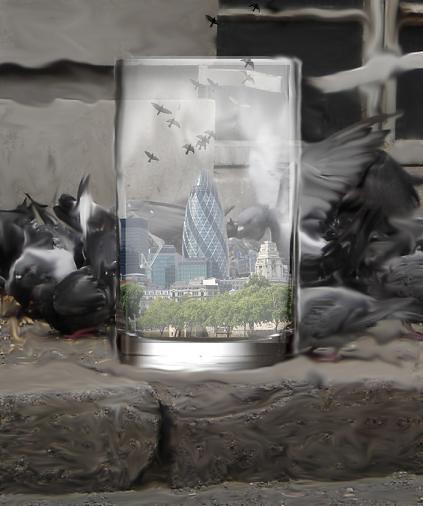My name is Sam Redlark. I am a carrier of the LonB gene which enables me to perceive parts of London that exist outside of the normal human sensory range. This blog is an account of the Capital as I experience it. I hope that my writing here will encourage those who find themselves in London, whether it is as a visitor, or as a resident, to seek a deeper appreciation of their surroundings. You don’t need to be a LonB carrier to experience the best of the city. All you need to do is open your senses to what is around you.
THE PIGEON PILGRIMAGE
Red Place, W1
Emma’s new duffle coat is bright red; the same colour as her mother’s knitted beret and the small family car they arrived in, which is now parked up on the opposite curb, across a narrow street of flat cobbles. Even the scattered flocks of grounded pigeons have a faint reddish glow about them. If Emma’s father were here he would crouch down at eye-level with his daughter. They would look at the birds and talk about them. He would explain to her the reason for their red aura, but it would be a made-up explanation tailored to appeal to the imagination of a small child.
Emma’s mother can’t see the glow. To her the pigeons are ordinary, their smudged ripples of grey plumage suppressing a faint spectrum of colours like an overcast metropolitan sky blotting out a rainbow. Talking into her mobile phone, she stares intently through the gleaming plate glass window of an upmarket antiques shop at a room full of impeccably-restored mahogany furniture, while she grips her daughter’s hand, sub-consciously responding to the child’s attempts to wriggle free by tightening her grasp around the tiny palm.
Emma points at one of the pigeons as it briefly takes flight. The red glow around the bird intensifies during its momentary ascent, then fades rapidly as it drops to the flagstones and resumes its graceless strut among the meandering flock.
Her mother’s attention is fixated on a table in the window. A square of dark wood reflecting a scuffed patch of light from a lamp overhead. The panelled surface of the table is divided into neat quarters, clearly demarking the area given over to each diner. These panels are held in place by an ornate clasped screw that forms an ornamental centrepiece. When this is removed they fold out to expand the dining area. The tables legs swell into tear-drop shaped feet, known in the trade as weepers. Each foot has a small gold crown affixed crookedly to the wood, denoting former royal ownership.
“There’s no price on it... It looks like one of those places where if you have to go in and make them an offer.”
“Can I talk to daddy?” says Emma.
“In a minute darling... No I don’t have any money with me... I have to use that for the shopping... Graham, I’m no good at haggling... I don’t want to get home and have you yelling at me because I paid too much for it... I don’t think it will fit in the car anyway... Can’t we drive down on Saturday?”
She relaxes her grip on her daughter’s hand, allowing it to drop. Emma's face takes on a concentrated sulky expression as she cradles her sore palm, staring down at it as she flexes it open and closed.
Red Place was constructed in one bold architectural flourish; two opposing rows of smart, red brick terraced housing rising to four storeys above ground; buildings with facades that extend beyond their pointed roofs, the sloped peaks of slate obscured behind shields of brick, built to resemble fireplaces. At the back the roofs flatten out and there are pigeon nurseries; weather-beaten coops managed by the council and tended to by elderly volunteers.
It is the birthplace of all true London pigeons. The newly fledged birds pour over the blocky crenulations that guard the rooftops, descending like angels from the low heavens of London, where they were born, to take their first faltering steps hemmed-in by a Venn diagram of sparrow hawk territories.
Emma’s mother finishes her phone call.
“Come on,” she says taking her daughter roughly by the hand.
In a doorway of the adjacent building someone has abandoned a parcel. Emma strains to look at it as she is dragged past. It is a large box wrapped in brown packing paper and then a layer of clear plastic that has been infiltrated by an earlier drizzle, beading the interior with condensation that obscures the print-out on a yellow delivery docket. A bright orange sticker attached to one side announces its delivery by The Pedal Crew Cycle Courier Service.
CONTINUES ON WEDNESDAY...Orange Place SE16


No comments:
Post a Comment